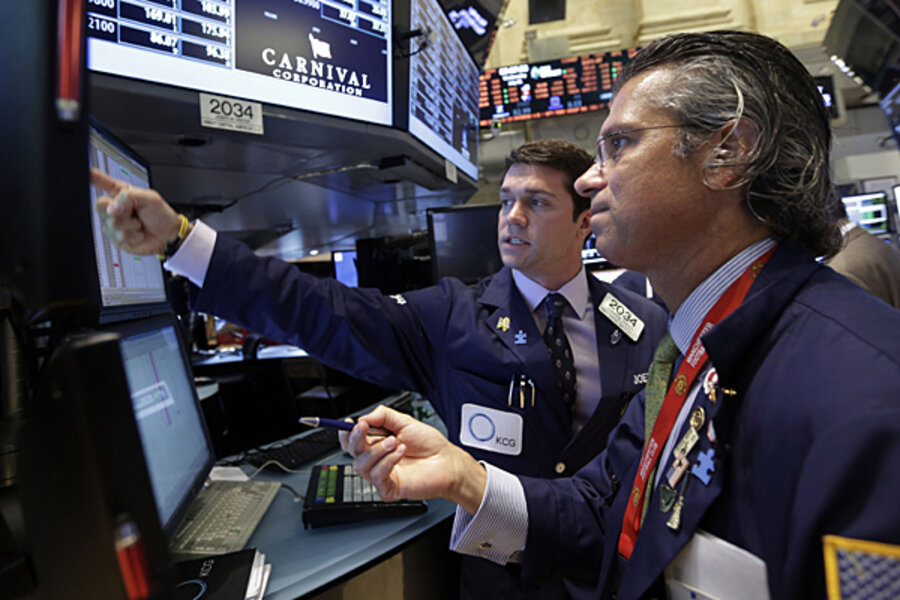Stocks rise after tepid jobs news
Loading...
| New York
A tepid jobs report Friday barely dented a summer rally on the stock market.
The Standard & Poor's 500 index ended the week 1 percent higher after breaking through 1,700 points for the first time Thursday. The index has risen for five of the last six weeks. The Dow Jones industrial average rose 0.6 percent and is on a streak of six weekly gains.
On Friday, indexes dropped in early trading after the U.S. added fewer jobs than forecast in July, curbing optimism that the economy is poised to pick up strength in the second half of the year. The market gradually recovered throughout the day and major indexes ended slightly higher. The gains were enough to set all-time highs for the Dow and S&P.
The government reported that 162,000 jobs were created last month, pushing the unemployment rate down to a 4½-year low of 7.4 percent. The number of jobs added was the lowest since March and below the 183,000 economists polled by FactSet were expecting.
Brad Sorensen, Charles Schwab's director of market and sector research, said the jobs report was "moderately disappointing."
"That tepid growth we've seen, (the economy) not being able to reach escape velocity, continues to be the story," Sorenson said.
Investors have been watching economic reports closely and trying to anticipate when the Federal Reserve will start easing back on its economic stimulus. The central bank is buying $85 billion in bonds every month to keep long-term interest rates low and encourage borrowing.
While the jobs report wasn't encouraging, it did make it more likely that the Fed would take its time cutting back on stimulus, said Doug Lockwood of Hefty Wealth Partners. The stimulus from the central bank has been an important factor powering a four-year bull run in stocks.
"As long as there's this concept that the Fed may still need to be involved and stimulate, that's good for both the bond and the stock market," said Lockwood. "You're seeing the trampoline effect; the market drops and then comes back up."
The S&P 500 ended Friday up 2.80 points, or 0.2 percent, to 1,709.67. The index is up 5 percent since the start of July. The Dow Jones industrial average rose 30.34 points, or 0.2 percent, to 15,658.36.
Seven of the 10 industry sectors that make up the S&P 500 gained, led by consumer discretionary stocks. Of the three groups that fell, energy stocks dropped the most.
Investors were also assessing company earnings.
Chevron fell after it became the latest big energy company to disappoint investors with lower earnings. Chevron's profit fell 26 percent to $5.4 billion due to lower oil prices and maintenance work at refineries. The stock fell $1.49, or 1.2 percent, to $124.95.
LinkedIn surged $23.58, or 10.6 percent, to $235.58 after the professional networking company's results topped analysts' estimates. LinkedIn had its biggest quarterly membership gain since going public in May 2011.
In other trading, the Nasdaq composite rose 13.84 points, or 0.4 percent, to 3,689.59.
The technology-heavy index got a boost from PC maker Dell, which gained 72 cents, or 5.6 percent, to $13.68 after a special committee of the company's board agreed to an increased offer from founder Michael Dell. The deal would add a special dividend for shareholders.
Government bonds rose after the weak employment report. The yield on the 10-year Treasury note, which falls when the note's price increases, fell to 2.60 percent from 2.71 percent Thursday. Bonds were regaining some lost ground after a sell-off Thursday prompted by a string of promising economic reports.
Investors will have to live with increasing volatility in the bond market in coming months as the Federal Reserve begins to wind down its stimulus program, said Ron Florance, managing director of investment strategy for Wells Fargo Private Bank.
The yield on the 10-year Treasury note is 1 percentage point higher than it was May 3, when it hit a low for the year of 1.63 percent.
Investors "are used to having stability in their bonds and volatility in their stocks," Florance said. "In the next 18 months it could be exactly the opposite, with stability in thestock market and volatility in the bond market."
The S&P 500 is up 19.9 percent this year, and has gained nine out of the last 10 months.
In commodities trading, the price of oil fell 95 cents, or 0.9 percent, to $106.94 a barrel. Gold fell 70 cents, or 0.1 percent, to $1,310.50 an ounce.
The dollar fell against the euro and the Japanese yen.
Among other stocks making big moves:
— Viacom surged $4.81, or 6.5 percent, to $79.17 after the media company said its income rose 20 percent in the latest quarter, boosted by affiliate fee revenue its cable TV channels and higher advertising revenue. Viacom also increased its stock buyback program to $20 billion from $10 billion.
— American International Group, the insurer the government bailed out during the financial crisis, rose $1.26, or 1.3 percent, to $48.33 after the company said late Thursday that its profit grew 17 percent in the second quarter. AIG also announced its first dividend since 2008 and said its board had approved a $1 billion stock buyback plan.
— Weight Watchers International plunged $9.04, or 19 percent, to $37.99 after the company reported late Thursday that its second-quarter net income fell 16 percent. The company also named a new CEO and said recruitment trends are weak.







